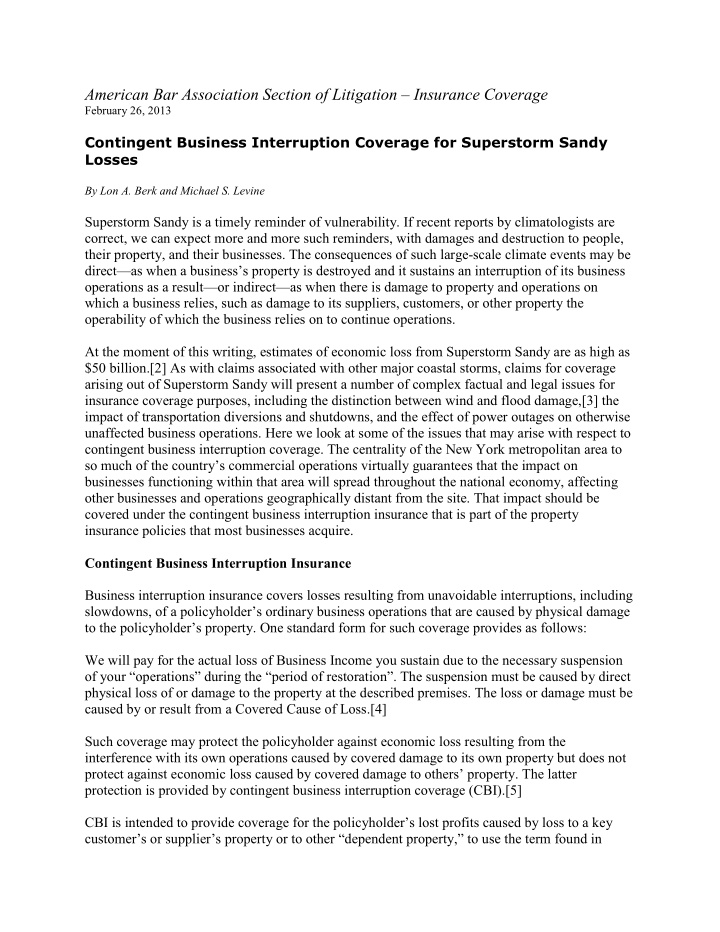



American Bar Association Section of Litigation – Insurance Coverage February 26, 2013 Contingent Business Interruption Coverage for Superstorm Sandy Losses By Lon A. Berk and Michael S. Levine Superstorm Sandy is a timely reminder of vulnerability. If recent reports by climatologists are correct, we can expect more and more such reminders, with damages and destruction to people, their property, and their businesses. The consequences of such large-scale climate events may be direct—as when a business’s property is destroyed and it sustains an interruption of its business operations as a result—or indirect—as when there is damage to property and operations on which a business relies, such as damage to its suppliers, customers, or other property the operability of which the business relies on to continue operations. At the moment of this writing, estimates of economic loss from Superstorm Sandy are as high as $50 billion.[2] As with claims associated with other major coastal storms, claims for coverage arising out of Superstorm Sandy will present a number of complex factual and legal issues for insurance coverage purposes, including the distinction between wind and flood damage,[3] the impact of transportation diversions and shutdowns, and the effect of power outages on otherwise unaffected business operations. Here we look at some of the issues that may arise with respect to contingent business interruption coverage. The centrality of the New York metropolitan area to so much of the country’s commercial operations virtually guarantees that the impact on businesses functioning within that area will spread throughout the national economy, affecting other businesses and operations geographically distant from the site. That impact should be covered under the contingent business interruption insurance that is part of the property insurance policies that most businesses acquire. Contingent Business Interruption Insurance Business interruption insurance covers losses resulting from unavoidable interruptions, including slowdowns, of a policyholder’s ordinary business operations that are caused by physical damage to the policyholder’s property. One standard form for such coverage provides as follows: We will pay for the actual loss of Business Income you sustain due to the necessary suspension of your “operations” during the “period of restoration”. The suspension must be caused by direct physical loss of or damage to the property at the described premises. The loss or damage must be caused by or result from a Covered Cause of Loss.[4] Such coverage may protect the policyholder against economic loss resulting from the interference with its own operations caused by covered damage to its own property but does not protect against economic loss caused by covered damage to others’ property. The latter protection is provided by contingent business interruption coverage (CBI).[5] CBI is intended to provide coverage for the policyholder’s lost profits caused by loss to a key customer’s or supplier’s property or to other “dependent property,” to use the term found in
many policies, not owned by the policyholder but relied on by the policyholder for its business operations. Typically, CBI requires the insurer to pay for the actual loss of Business Income the insured sustains due to the necessary suspension of its operations during the “period of restoration.” The suspension must be caused by the direct physical loss of or damage to “dependent property.”[6] Sometimes this coverage is provided only where the dependent property is identified in a schedule and where the cause of loss is identified as covered. But that need not be the case, and most policies define “dependent properties” generally to include contributing locations, recipient locations, manufacturing locations, and leader locations even if they are not specifically identified in the policy.[7] “Contributing locations” are locations where the insured’s suppliers operate. “Recipient locations” are locations where the insured’s customers operate. And a “leader location” is a magnet location that attracts customers to the insured’s business. According to a widely used Insurance Services Office (ISO) form: “Dependent property” means property operated by others whom you depend on to: a. Deliver materials or services to you, or to others for your account (Contributing Locations). But any property which delivers any of the following services is not a Contributing Location with respect to such service; (1) Water supply services; (2) Power supply services; or (3) Communication supply services, including services relating to internet access or access to any electronic network; b. Accept your products or services (Recipient Locations). c. Manufacture products for delivery to your customers under contract of sale (Manufacturing Locations); d. Attract customers to your business (Leader Locations).[8] Dependent or Contributing Property What constitutes a dependent or contributing property has been the subject of some litigation over the years, and the issue was again addressed very recently in Millennium Inorganic Chemicals v. National Union Fire Insurance Co. of Pittsburgh.[9] There the policy language required insurers to cover loss resulting from damage to “direct contributing properties” that are “not operated by the insured.”[10] In Millennium, the policyholder sought coverage for loss resulting from the shutdown of its titanium oxide manufacturing operations, located in Australia, after an explosion caused disruption of the insured’s supply of natural gas, a key component in the manufacture of its product. The loss of natural gas supply was caused by a massive explosion at a natural gas production facility on Varanus Island, off the coast of Western Australia, operated by a joint venture led by Apache Corporation. The explosion completely shut down Apache’s gas production on Varanus Island, which accounted for approximately 30 percent of the natural gas supply to all of Western Australia. Immediately after the explosion, the supply of natural gas to Millennium’s facilities was terminated, and, without natural gas, Millennium was forced to suspend production of titanium dioxide. Shortly after the explosion, Millennium submitted a claim to its insurers for coverage under the applicable policies. That claim was denied.
Recommend
More recommend